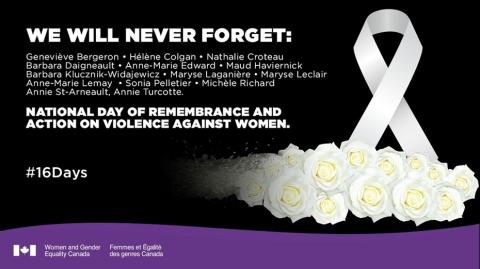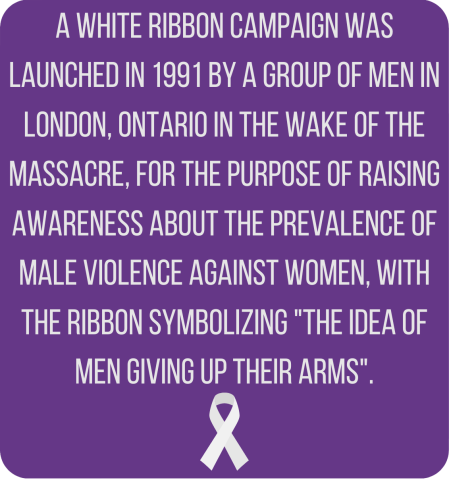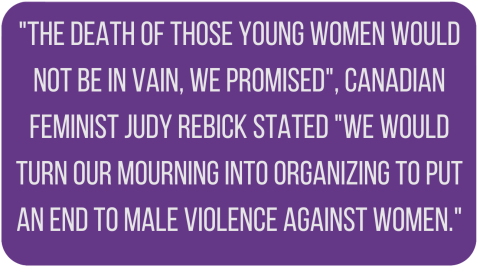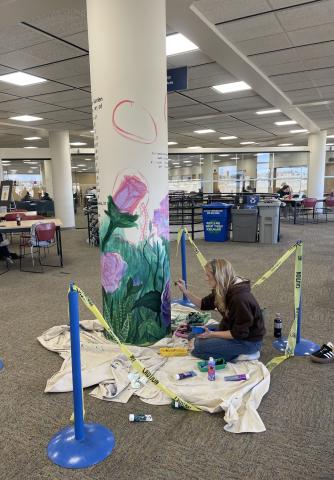National Day of Remembrance and Action on Violence Against Women
National Day of Remembrance and Action on Violence Against Women
The National Day of Remembrance and Action on Violence Against Women, also informally known as White Ribbon Day, is a day commemorated in Canada each December 6, which is the anniversary of the 1989 École Polytechnique massacre, in which an armed student murdered fourteen women and injured fourteen others in the name of "fighting feminism". The commemoration date was established by the Parliament of Canada in 1991.


December 6, 1989: Ecole Polytechnique Massacre
Remembering:
- Geneviève Bergeron (aged 21), civil engineering student
- Hélène Colgan (aged 23), mechanical engineering student
- Nathalie Croteau (aged 23), mechanical engineering student
- Barbara Daigneault (aged 22), mechanical engineering student
- Anne-Marie Edward (aged 21), chemical engineering student
- Maud Haviernick (aged 29), materials engineering student
- Maryse Laganière (aged 25), budget clerk in the École Polytechnique's finance department
- Maryse Leclair (aged 23), materials engineering student
- Anne-Marie Lemay (aged 22), mechanical engineering student
- Sonia Pelletier (aged 28), mechanical engineering student
- Michèle Richard (aged 21), materials engineering student
- Annie St-Arneault (aged 23), mechanical engineering student
- Annie Turcotte (aged 20), materials engineering student
- Barbara Klucznik-Widajewicz (aged 31), nursing student
The École Polytechnique massacre also known as the Montreal massacre, was an antifeminist mass shooting that occurred on December 6, 1989, at the École Polytechnique de Montréal in Montreal, Quebec. Fourteen women were murdered; another ten women and four men were injured.
Sometime after 4 p.m. on December 6, 1989, the gunman, a 25-year-old male, arrived at the École Polytechnique, an engineering school affiliated with the Université de Montréal, armed with a rifle and a knife. He separated the male and female students in the classroom and after separating the students, he ordered the men to leave the room. He then asked the women if they knew why they were there; a student asked who he was and he indicated that he was fighting feminism. One of the students protested that they were women studying engineering, not feminists fighting against men or marching to prove that they were better. He opened fire on the students, from left to right, killing six and wounding three others.
For nearly 20 minutes the shooter moved through corridors on multiple floors of the building, the cafeteria, and another classroom, targeting women. He wounded more students and killed eight more women before fatally shooting himself. In total, he killed 14 women; he wounded 10 other women and four men. The massacre is now widely regarded as an act of misogynist terrorism and representative of wider societal violence against women. The anniversary of the massacre is commemorated annually as the National Day of Remembrance and Action on Violence Against Women.
Over the years, Canadians have responded to the massacre with many memorials demonstrating the commitment to remembering these victims. Ensuring that people will continually become more aware of the incident and encourage individuals to recognize how often violence occurs towards women. Canadian flags on all federal buildings – including the Peace Tower on Parliament Hill in Ottawa – are flown at half-mast on December 6. Canadians are also encouraged to observe a minute of silence on December 6 and to wear a white ribbon (or a purple ribbon) as a commitment to end violence against women.


University of Lethbridge: Peace Memorial Garden

